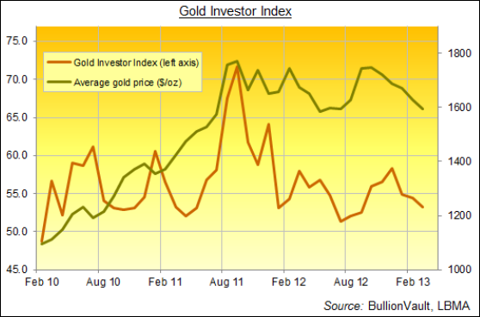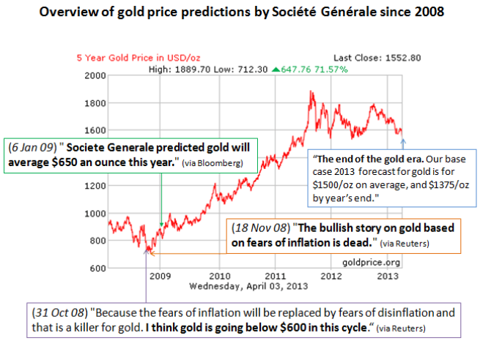Dismal Labor Report Gives Precious Metals Markets New Life
Apr 7 2013, 10:25
by: Tim Iacono
.
The announcement of record money printing by the Bank of Japan and the prospect of more "quantitative easing" from the Bank of England this summer did little to support precious metals prices as sentiment in this sector remains poor. While demand from both the public and private sector in emerging market nations remains strong and U.S. coins sales are on track to shatter previous record sales, the much bigger futures market is clearly in control of metal prices as traders jump from "paper gold and silver" to other asset classes.
Last week's price declines were aided by continued strength in the U.S. dollar and by a number of bearish reports from investment banks and other groups, highlighted by a study from Societe Generale heralding "The end of the gold era". Like many other similar papers published in recent months, this report was much less than meets the eye, however, just its title added to the recent selling in gold and silver markets.
For the week, the gold price fell 1.0 percent, from $1,597.60 an ounce to $1,582.30, and silver fell 3.4 percent, from $28.30 an ounce to $27.35. Gold is now down 5.5 percent this year, 17.7 percent below its 2011 high, and silver is 9.9 percent lower in 2013, down 44.7 percent from its high two years ago.
To be sure, the performance of U.S. equity markets has sapped much of the demand for precious metals in recent months, that is, since gold and silver failed to rally after the announcement of the Federal Reserve's latest money printing gambit in December.
As shown in BullionVault's sentiment index below, even the "Crisis in Cyprus" failed to brighten gold investors' mood last month, however, it's important to note that there was a huge 167 percent surge in new accounts from people in Spain and Italy.
(click to enlarge)

As detailed in A Slow Motion Run On European Banks Will Benefit Gold, the impact on precious metals markets of the Cyprus bail-in deal (where billions in depositor savings were seized) is likely to play out over an extended period of time as wealthy investors rethink their relationship with their bank.
Here in the U.S., investors and traders remain fixated on equity markets that again reached record highs before pulling back late in the week. Clearly, the "hot money" from hedge funds has been directed toward the S&P500 with little interest in precious metals other than from the short side, however, Friday's labor report may have changed that, spurring a furious short-covering rally in the process.
Part of the mid-week sell-off was driven by comments from San Francisco Fed President John Williams who said that, by this summer, the central bank could start tapering its $85 billion-a-month money printing effort. The prospect of less monetary accommodation from the Fed and an improving labor market have been key factors behind the bearish sentiment and lower prices for gold and silver, but the weak jobs data has clearly reduced the chance that the Fed would alter its bond buying program over the near term.
During a speech in Los Angeles, Williams said, "Assuming my economic forecast holds true, I expect we will meet the test for substantial improvement in the outlook for the labor market by this summer. If that happens we could start tapering our purchases then".
Williams likely had another look at his economic forecasts over the weekend after the worst payrolls miss in almost two years.
The Bank of Japan embarked on a breathtaking new money printing effort as new governor Haruhiko Kuroda announced he will double the size of Japan's monetary base in less than two years by increasing its asset purchase program to 7 trillion yen ($72 billion) per month.
This represents 15 percent of Japan's economic output and, as a share of the economy, would be the equivalent of the Federal Reserve more than doubling its current $85 billion bond purchase program!
While the yen plunged to a three-and-a-half year low and the Nikkei stock index surged, gold traders saw little reason to do anything but sell.
Incoming Bank of England Governor Mark Carney is expected to begin a new money printing effort soon after taking charge this summer, but, even with the prospect of the world's major central banks printing nearly $200 billion in new money each month, precious metals prices fell.
Such is the mood in gold and silver markets these days.
To some degree, this view is justified since, in most of the West, inflation has been tame even after global central banks have created $5 trillion in new money to combat the effects of the 2008 financial crisis and the recession that it spawned. But, that doesn't mean that inflation will stay contained forever, particularly now that the pace of money printing has been ratcheted up significantly.
A good way to look at this is to consider that, if central banks around the world had been printing money from 2008 to 2012 at the same pace as they will in 2013, instead of growing from about $5 trillion to $10 trillion, total central bank balance sheets would have risen closer to $20 trillion! As detailed in Why Current Fed Money Printing Will Lead To Higher Gold And Silver Prices last month, this is sure to result in higher inflation.
Lower metal prices are expected to attract more buying in India where the world's most price sensitive (and biggest) buyers are found. Last week Finance Minister P. Chidambaram intimated that the government is through with gold import duty hikes that have tripled over the last year and dented demand (while also spurring a brisk smuggling trade).
Instead, inflation-indexed investments will be offered to the Indian people in order to curb their centuries long love for the yellow metal and help reduce the nation's trade deficit.
I doubt there will be many converts.
Here in the U.S., investors continue to sell precious metals ETFs and buy equities as the SPDR Gold Shares ETF (GLD) shed 16 tonnes last week while the iShares Silver Trust ETF (SLV) saw 226 tonnes exit the trust. While GLD has seen steady outflows for months, the 180 tonnes of silver that left the SLV trust on Friday was the biggest one-day decline in more than two months, but SLV holdings are still up 421 tonnes so far this year.
Silver recently tested critical support levels at around $27 an ounce - near the 2012 lows - and, if not for Friday's big price surge, there would be a much more negative outlook for the metal in the week ahead.
Silver coin investors, however, remain positive about the metal's prospects while adding to their holdings as the U.S. Mint is on pace to shatter previous records after American Eagle silver coin sales reached an all-time high in the first quarter. The mint reported total sales of 14.2 million ounces of silver through March 31, 2013, a pace that would easily eclipse the prior full-year sales record of 39.9 million ounces in 2011.
But, there remains a big disconnect between physical markets and paper markets and the latter clearly rule.
As if paper market traders needed more reasons to sell, Societe Generale published one of the most bearish reports on precious metals in some time titled The end of the gold era.
The French bank sees the gold price falling to $1,375 an ounce by year end while averaging $1,500 an ounce this year and $1,400 an ounce in 2014. Fortunately for investors, it's hard to take this report seriously given the group's track record as shown below, courtesy of GoldSilverWorlds.
(click to enlarge)

Add to this the fact that most of the report's seven authors are economists and it becomes laughable.
Economists hate everything about gold because the very notion of gold as anything other than an ordinary commodity is in conflict with everything they learned about how the financial world works in college and everything they experienced in their careers, that is, up until the wheels fell off of the global financial system a few years ago.
Since then, the world has leapt from one mini-crisis to another as paper money gushes out of the world's central banks with little apparent improvement in the global economy, endangering an already-shaky global monetary system. The group doesn't even appear to understand asset bubbles (an affliction that most economists share) as they offered up the following gem:
The gold price is, in our view, in bubble territory... Our central scenario calls for a gentle bear market over the next several years.
Asset bubbles don't end in "a gentle bear market".
In short, the report's base case is the same as many others lately. The working assumption is that economic growth will pick up without creating high levels of inflation or a new financial crisis and whatever compulsion investors felt to own gold over the last dozen years is no longer warranted.
If you want to trade precious metals or invest long-term based on the views of economists at Societe Generale, go ahead. But, you've been warned.

0 comments:
Publicar un comentario